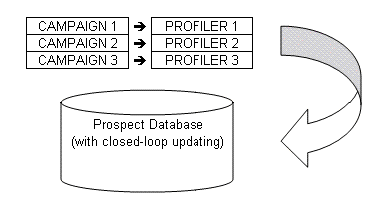An Online Marketing Prescription
An Online Marketing Prescription
|
TechTransform, October 4, 2004: In the ideal online marketing model, there is very little human “sales persuasion” going on. The system is doing it. Here is a prescription for setting up the "system" - simple, scalable and successful.
Attracting Prospects
Prospects are attracted to the sales site through a combination of online marketing methods.
What gets them there is usually a focused point of interest or need; but once there, they will often “noodle around” the site to get to know the company and its offerings.
They may even play some informational Flash-style (Robodemo, Viewlets) demos and presentations; but only if those are quick, easy and to the point. (PDF documents are not the best, as Acrobat loads so sloooowly.)
[Editor's note: Acrobat Reader Version 7 has solved this problem to a great degree.]
Prospect Conversation
At some point, the visitor will agree to engage in a conversation with the company. This is done through various opt-in methods, but the best is an interactive qualifying dialog that has logical “branches” that keep the user on-topic (click here for more on this).
From here on, any human involvement is to assist, to guide, to answer questions.
This requires a sales microsite, which I describe fully in my article Web Sales Weapons.
Automated Communications
Even if you talk to your prospects (and often the price of what you sell doesn't justify it), you still have to keep in touch with them using automated communications that are personalized to the prospect's needs.
Here are some resources for implementing those communications.
Software:
Services:
Fleshing Out the Site: Minimal and Optimal Elements
It’s not enough to equip the sales microsite. Success also depends on answering the audience’s many questions about the company and its products. The checklist here outlines both minimum and optimal elements for any software product site.
E-commerce & Affiliate Management Considerations
Some developers like to send their commerce to Digital River and this has the potent benefit of bringing about a lot of cross-promotion with the hundreds of developers. But the 20% charge is a major consideration.
Also, every e-marketer has to find a way to tap into the captive audiences on Amazon, Yahoo! Shopping and eBay.Keep it simple at first, but be sure to have a program to move into these markets.
In addition, there is the decision about how to manage the affiliate network. Outside networks such as Commission Junction and Linkshare can be retained. Alternatively, a powerful affiliate management product like My Affiliate Program can be implemented. But all of this may be too much for early stage deployment: you may want to work with just a few key partners at first.
Fast-Flow Sales
The classic case study for fast-flow online selling is GoToMyPC. The model is a short trial or even none at all, and an inline (real-time) invitation to commit to a subscription with a hot, special offer.
Many marketers get signups by offering the first month free, but with a credit card. That way, subsequent months tend to be billed rather than not.
(This is called negative option, because the subscriber has to say "no" to stop being billed. Negative option campaigns can get a bad name unless you implement excellent permission and notification systems!)
A Startup Platform
In startup mode, resources are missing to deploy much of this. Therefore it is recommended that an all-in-one solution be implemented. The current recommended package is 1ShoppingCart. This is used by many top e-commerce operators. It is inexpensive, about the cost of a gym membership, and has no per-sale costs. See the Pro Package features here.
Another choice is Site Build-It. This is a marketing-enabled site system that requires a separate investment in e-commerce. It would be recommended for a company choosing to go with Digital River, for example.
One final option is to have a comprehensive commerce-enabled platform built by a web design agency. I've been working with Itensil on a blog-style dynamic website - very cool. I'll be happy to turn you on to them.
Lead Generation
Having built all this, we have to think about how to get a flow of prospects to the site. There are many methods.
Not all of it can be done at the same time, by a long shot. Instead, a main strategy needs to be selected and the many lead generation options organized behind it.
Clearly, it is far better to do one thing well than twelve things badly or not at all, because you can get overwhelmed and run out of money and people to do it.
Here are the methods:
1. Search Engine Marketing (unpaid).
Generally this is accomplished by getting as many other sites to link to your site as possible. These are some of the methods, you can do all three or just one.
2. Search Engine Marketing (paid).
These are the well-known Overture, Yahoo and Google advertiser programs. A great deal of experimentation is required to find the key words that work. Often a low-cost, low traffic keyword will be very productive as it gets the exact prospect. It’s best to invest in a tool like Atlas OnePoint to manage it all or it will be like playing 21 in Vegas: goodbye budget!
3. Product Review Sites.
This is a placement activity requiring a lot of continuous and diligent attention.
4. Editorial Placement.
Editorial placement is done by developing stories and pitching them to the media. Stories are often pre-written. This is most effectively done by a trained PR practitioner with a personal network, as it will take “friends” to first start covering an unknown player.
5. In-House Publication.
An in-house newsletter is highly valuable. These are the key factors:
Using a blog format is great because you're building a site and a newsletter at the same time.
For a great example, check out MarketingVox, built on the outstanding blog platform Movable Type. They have a simple version called TypePad. WordPress is also powerful.
(Also check out Drupal, well implemented by the web design agency Itensil on its own site. Drupal's not for amateurs, though!)
6. Community Micro-Marketing
User communities are ideal penetration targets as they are viral in nature.
- Beta testers can be leveraged as viral recommenders and as first sources of revenue.
- Do not go wide with a marketing beta campaign on a poor quality product as you can blemish the product’s word of mouth for good.
A variation on this is launching an industry association for your segment. But it does require the resources.
7. Paid Advertising
Paid advertising is a waste of money if it consists of hot offers from someone who is not known.
It can be done. The most effective method is to find a topic of concern to the audience and to promote the editorial value of this topic, tied in with a valuable benefit to that audience.
8. Product Bundles and Promotional Partnerships
This is also known as activating your channel. It is virtually free except that you have to have someone working the deals consistently.
The key to effective promotional marketing is to find the offer that has commodity value to the audience, and leverage that. I explored this theme in my Panda case study, here.
A version of this that does involve some money is coop marketing, where you subsidize the promotional expenditures of your partners.
The Vital Importance of Strategy
Again, you have to choose to focus on something and let that be your main calling card.
This decision is mission-critical and should not be done lightly. As Jack Trout (co-author of the 1981 classic, Positioning) says...“If You Don't Have the Right Strategy, You're Toast.” He says strategy is about winning a place in the mind of consumers ahead of the competition. (Source)
Make sure you have chosen a strategy that, if executed, will win that place. And then execute.
But... you'll probably have to learn what works from experience. It's rare you'll know ahead of time. That's why we have Mistake Based Marketing...
Let me know how it goes - just click on my signature to email me. Your success could even become a case study!
Riggs Eckelberry
Originally written May 17, 2004
Posted October 4, 2004
Updated March 26, 2005
|
Copyright © 1996-2011 Riggs Eckelberry Marketing Group, Inc. All Rights Reserved
TechTransform and the interlocked "T" are trademarks of REMG, Inc.


